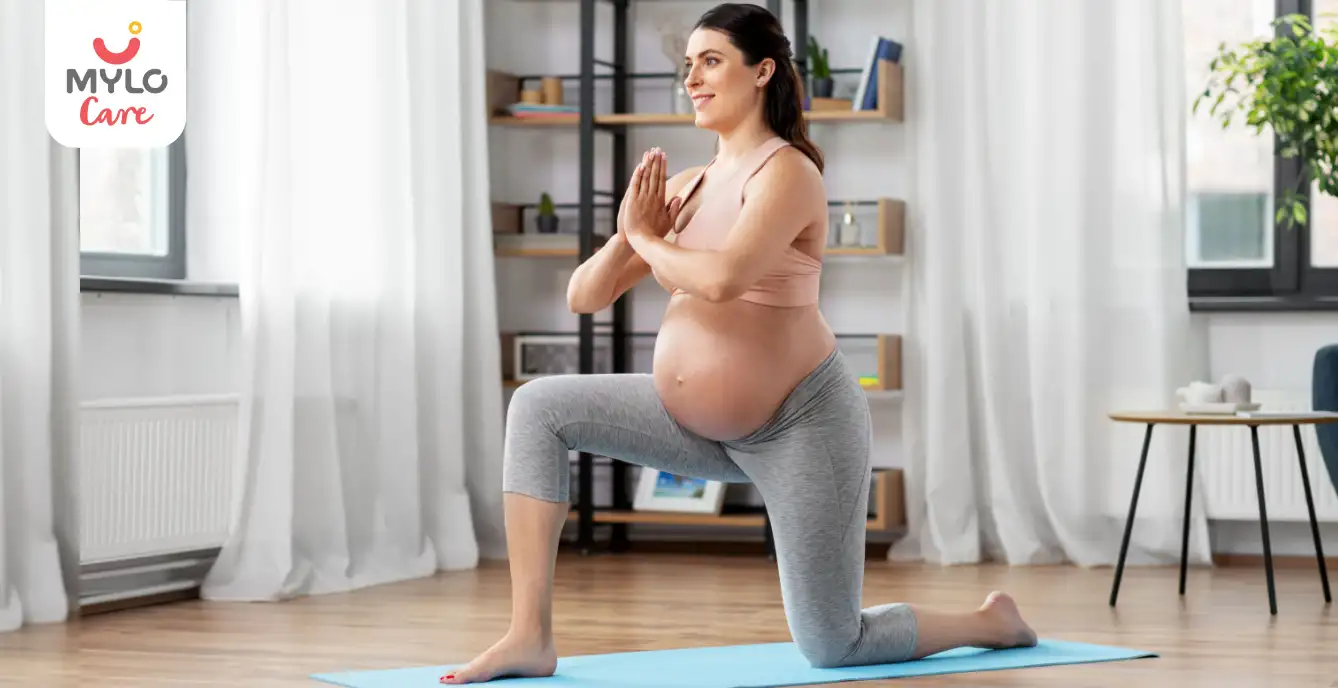Home

The ABCs of Cephalic Presentation: A Comprehensive Guide for Moms-to-Be
In this Article

Pregnancy
The ABCs of Cephalic Presentation: A Comprehensive Guide for Moms-to-Be
Updated on 24 November 2023
As expectant mothers eagerly anticipate the arrival of their little ones, understanding the intricacies of pregnancy becomes crucial. One term that frequently arises in discussions about childbirth is "cephalic presentation." In this article, we will understand its meaning, types, benefits associated with it, the likelihood of normal delivery and address common concerns expectant mothers might have.
What is the meaning of cephalic presentation in pregnancy?
Cephalic presentation means the baby's head is positioned down towards the birth canal, which is the ideal fetal position for childbirth. This position is considered optimal for a smoother and safer delivery. In medical terms, a baby in cephalic presentation is said to be in a "vertex" position.
The majority of babies naturally assume a cephalic presentation before birth. Other presentations, such as breech presentation (where the baby's buttocks or feet are positioned to enter the birth canal first) or transverse presentation (where the baby is lying sideways), may complicate the delivery process and may require medical intervention.
Cephalic presentation types
There are different types of cephalic presentation, each influencing the birthing process. The primary types include:
1. Vertex Presentation
The most common type where the baby's head is down, facing the mother's spine.
2. Brow Presentation
The baby's head is slightly extended, and the forehead presents first.
3. Face Presentation
The baby is positioned headfirst, but the face is the presenting part instead of the crown of the head.
Understanding these variations is essential for expectant mothers and healthcare providers to navigate potential challenges during labor.
You may also like: How to Get Baby in Right Position for Birth?
What are the benefits of cephalic presentation?
In order to understand whether cephalic presentation is good or bad, let’s take a look at its key advantages:
1. Easier Engagement
This presentation facilitates the baby's engagement in the pelvis, aiding in a smoother descent during labor.
2. Reduced Risk of Complications
Babies in head-first position typically experience fewer complications during delivery compared to other presentations.
3. Faster Labor Progression
This position is associated with quicker labor progression, leading to a potentially shorter and less stressful birthing process.
4. Lower Cesarean Section Rates
The chances of a cesarean section are significantly reduced when the baby is in cephalic presentation in pregnancy.
5. Optimal Fetal Oxygenation
The head-first position allows for optimal oxygenation of the baby as the head can easily pass through the birth canal, promoting a healthy start to life.
What are the chances of normal delivery in cephalic presentation?
The chances of a normal delivery are significantly higher when the baby is in cephalic or head-first presentation. Vaginal births are the natural outcome when the baby's head leads the way, aligning with the natural mechanics of childbirth.
While this presentation increases the chances of a normal delivery, it's important to note that individual factors, such as the mother's pelvic shape, the size of the baby, and the progress of labor, can also influence the delivery process. Sometimes complications may arise during labor and medical interventions or a cesarean section may be necessary.
You may also like: Normal Delivery Tips: An Expecting Mother's Guide to a Smooth Childbirth Experience
How to achieve cephalic presentation in pregnancy?
While fetal positioning is largely influenced by genetic and environmental factors, there are strategies to encourage head-first fetal position:
1. Regular Exercise
Engaging in exercises such as pelvic tilts and knee-chest exercises may help promote optimal fetal positioning.
2. Correct Posture
Maintaining good posture, particularly during the third trimester, can influence fetal positioning.
3. Hands and Knees Position
Spend some time on your hands and knees. This position may help the baby settle into the pelvis with the head down.
4. Forward-leaning Inversion
Under the guidance of a qualified professional, some women try forward-leaning inversions to encourage the baby to move into a head-down position. This involves positioning the body with the hips higher than the head.
5. Prenatal Yoga
Prenatal yoga focuses on strengthening the pelvic floor and promoting flexibility, potentially aiding in cephalic presentation.
6. Professional Guidance
Seeking guidance from a healthcare provider or a certified doula can provide personalized advice tailored to individual needs.
FAQs
1. Cephalic presentation is good or bad?
Cephalic position is generally considered good as it aligns with the natural process of childbirth. It reduces the likelihood of complications and increases the chances of a successful vaginal delivery. However, it's essential to note that the overall health of both the mother and baby determines its appropriateness.
2. How to increase the chances of normal delivery in cephalic presentation?
Increasing the chances of normal delivery in cephalic presentation involves adopting healthy practices during pregnancy, such as maintaining good posture, engaging in appropriate exercises, and seeking professional guidance. However, individual circumstances vary, and consultation with a healthcare provider is paramount.
Final Thoughts
Navigating the journey of pregnancy involves understanding various aspects, and cephalic presentation plays a crucial role in determining the birthing experience. The benefits of a head-first position, coupled with strategies to encourage it, empower expectant mothers to actively participate in promoting optimal fetal positioning. As always, consulting with healthcare professionals ensures personalized care and guidance, fostering a positive and informed approach towards childbirth.
References
1. Makajeva J, Ashraf M. Delivery, Face and Brow Presentation. (2023). In: StatPearls [Internet]. Treasure Island (FL): StatPearls Publishing
2. Boos R, Hendrik HJ, Schmidt W. (1987). Das fetale Lageverhalten in der zweiten Schwangerschaftshälfte bei Geburten aus Beckenendlage und Schädellage [Behavior of fetal position in the 2d half of pregnancy in labor with breech and vertex presentations]. Geburtshilfe Frauenheilkd



Written by
Anupama Chadha
Anupama Chadha, born and raised in Delhi is a content writer who has written extensively for industries such as HR, Healthcare, Finance, Retail and Tech.
Read MoreGet baby's diet chart, and growth tips

Related Articles
RECENTLY PUBLISHED ARTICLES
our most recent articles

Diet & Nutrition
The Ultimate Guide to Consuming Chia Seeds in Pregnancy

Tips For Normal Delivery
Essential Tips for Normal Delivery After Cesarean

Diet & Nutrition
Crab During Pregnancy: Benefits, Risks and Smart Choices

Tips For Normal Delivery
Normal Delivery Tips: An Expecting Mother's Guide to a Smooth Childbirth Experience

Stories
Top 10 Panchatantra Stories in English You Must Read to Your Children

Health & Wellness
What Helps in Improving Mental Health of Women
- Childhood Disorders: Meaning, Symptoms & Treatment
- Bleeding During Pregnancy 8 Weeks: Should You See a Doctor?
- The Ultimate Guide to Having Sex After C Section
- The Ultimate Guide to Baby Brain Development Food During Pregnancy
- Nappy Rash: Your Ultimate Guide to Symptoms and Quick Relief
- How to Get Periods Immediately to Avoid Pregnancy?
- Loss of Appetite During Pregnancy: Causes and Solutions
- How to Increase Newborn Baby Weight: Expert Tips and Tricks
- Fertisure M: The Comprehensive Solution to Male Infertility and Reproductive Health
- All You Need to Know About the New COVID Variant: Pirola
- Endometrial Polyp and Pregnancy: How Uterine Polyps Can Affect Your Chances of Conception
- How to Stop Heavy Bleeding During Periods: Home Remedies (Part 2)
- How Many Times Should You Have Sex to Get Pregnant?
- A Guide to Planning the Perfect Godh Bharai for the Mom-to-Be


AWARDS AND RECOGNITION

Mylo wins Forbes D2C Disruptor award

Mylo wins The Economic Times Promising Brands 2022
AS SEEN IN
















- Mylo Care: Effective and science-backed personal care and wellness solutions for a joyful you.
- Mylo Baby: Science-backed, gentle and effective personal care & hygiene range for your little one.
- Mylo Community: Trusted and empathetic community of 10mn+ parents and experts.
Product Categories
baby carrier | baby soap | baby wipes | stretch marks cream | baby cream | baby shampoo | baby massage oil | baby hair oil | stretch marks oil | baby body wash | baby powder | baby lotion | diaper rash cream | newborn diapers | teether | baby kajal | baby diapers | cloth diapers |








